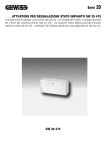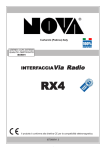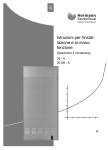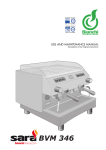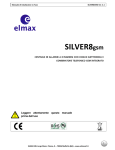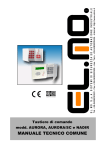Download INT W ist0502v2.0
Transcript
AZIENDA CON SISTEMA QUALITA’ CERTIFICATO ISO9001 AVS ELECTRONICS Curtarolo (Padova) Italy www.avselectronics.com SCHEDA SA TELLITEVia SATELLITE Radio DOPPIA FREQUENZA SAT W / Int W E SINGOLA FREQUENZA SAT W W_S / Int W_S Il prodotto è conforme alla direttiva CE per la compatibilità elettromagnetica. IST0502V2.0 -1- I T A E N G Indice I T A Generalità ......................................................................................................................................pag. 3 Caratteristiche generali ...............................................................................................................pag. 3 Compatibilità SAT W / SAT W_S con centrali AVS Electronics ..................................................pag. 3 Scheda satellite SAT W / SAT W_S ..............................................................................................pag. 4 Scheda satellite Int W / Int W_S ...................................................................................................pag. 4 Fusibili ....................................................................................................................................pag. 4 Morsettiera SAT W / SAT W_S e Int W / Int W_S .........................................................................pag. 5 Installazione ..................................................................................................................................pag. 5 Installazione antistrappo ..............................................................................................................pag. 6 Posizionamento Batteria ed ingresso cavi ................................................................................pag. 6 Posizionamento etichetta dati targa ...........................................................................................pag. 6 Collegamento SAT W / SAT W_S con la centrale .......................................................................pag. 7 Collegamento Int W / Int W_S con la centrale ............................................................................pag. 7 Indirizzamento dei Satelliti ..........................................................................................................pag. 8 Indirizzamento Sat W / Sat W_S SW1 Dip (6, 7, 8) : ...........................................................pag. 8 Sat W / Sat W_S Singolo/Doppio SW1 Dip (1, 2, 3, 4) : ......................................................pag. 8 Display per Int W / Int W_S e Sat W / Sat W_S ............................................................................pag. 8 Visualizzazioni sensori .........................................................................................................pag. 8 Visualizzazione: Display / Led / uscita a relè abbinata (Int W / Int W_S): ........................pag. 9 Segnalazioni sul Display .......................................................................................................pag. 9 Segnalazioni sul Display ad impianto spento (solo Int W / Int W_S) ................................pag. 9 Programmazione Satellite Sat W / Sat W_S e Int W / Int W_S ...................................................pag. 9 Programmazione tramite Dip Switch ...................................................................................pag. 9 Visualizzazione allarmi ..........................................................................................................pag. 10 Lista sensori acquisiti ...........................................................................................................pag. 10 Test sensori e potenza (attenuatore inserito) ...................................................................pag. 10 Test memorizzazione dei sensori .......................................................................................pag. 10 Acquisizioni sensori ..............................................................................................................pag. 10 Cancellazione sensori ..........................................................................................................pag. 10 Impostazione tempo sopravvivenza ...................................................................................pag. 10 Cancellazione di tutti i sensori ............................................................................................pag. 11 Tamper Sat W / Sat W_S ...............................................................................................................pag. 11 Tamper Int W / Int W_S ..................................................................................................................pag. 11 Uscite di allarme ...........................................................................................................................pag. 11 Uscite attive Sat W / Sat W_S ......................................................................................................pag. 11 Uscite attive Int W / Int W_S .........................................................................................................pag. 11 Telecomando - BIP .......................................................................................................................pag. 12 Acquisizioni Telecomandi .....................................................................................................pag. 12 Funzione a STATO o IMPULSIVA .........................................................................................pag. 12 Funzionamento ......................................................................................................................pag. 12 Ripristino totale Scheda INT WS .........................................................................................pag. 12 Il sistema via radio ........................................................................................................................pag. 13 Sensori via radio ...........................................................................................................................pag. 14 WIC (_S) (Contatto), WIB (_S) (Tenda), WIR (_S) (Volumetrico) ........................................pag. 15 Installazione dei sensori via radio ......................................................................................pag. 15 Installazione dei sensori switch-alarm ed inerziali (Solo con sensore WIC / WIC_S) ....pag. 15 S1 - Antistrappo .....................................................................................................................pag. 15 SW1 - Numerazione dei sensori ..........................................................................................pag. 16 SW1 - Programmazione dei sensori ....................................................................................pag. 16 Acquisizione dei sensori (Sat W / Sat W_S) ........................................................................pag. 16 Cancellazione sensori (Sat W / Sat W_S .............................................................................pag. 16 Cancellazione sensori (simultanea) ....................................................................................pag. 17 Verifica sensori (Sat W / Sat W_S) ......................................................................................pag. 17 Informazioni in conformità con la direttiva 1999/5/cee (r&tte) .................................................pag. 34 Dichiarazione di conformità SAT W (S) / INT W (S) - Declaration of conformity .....................pag. 35 -2- ESPANSIONE SAT W / SAT W_S / Int w / Int W_S Manuale di Installazione Generalità Il Satellite via radio permette di ampliare un impianto tradizionale via filo utilizzando la linea di sensori “Concode Web” che ci consentono di migliorare la protezione dell’impianto. Questa scheda è inserita in un contenitore termoplastico che ottimizza la resa del ricevitore. SAT W e SAT W_S radio possono essere posti anche a distanza dalla centrale a seconda delle esigenze installative sfruttando il collegamento seriale RS485. Caratteristiche generali Linee di ingresso n° 3 2 ( o n° 1 6 , d ip e nd e d a lla c o nf ig ur a zio ne s c e lt a ) c o nf ig ur a b ili c o n r i l e v a z i o ne a ut o m a t i c a d e l l o s t a t o d i a l l a r m e e d i a nt i m a no m i s s i o ne programmabile singolarmente; ogni ingresso può essere programmato in una delle possibili modalità di funzionamento. Uscite di allarme: n° 1 relè di allarme supplementare a sicurezza positiva, programmabile (Sat W / SAT W_S). n° 8 uscite transistorizzate (50 mA - Open Collector) su connettore e per collegament o con scheda a relè, a richiest a. Sono associabili a qualsiasi funzione della centrale e completamente configurabili (Sat W / SAT W_S). n°3 us c i t e d e d i c a t e p e r l a s e g na l a zi o ne d i B a t t e r i a B a s s a S e ns o r i , Sopravvivenza ed Interferenza Radio. Frequenza SAT W e Int W: 868 MHz a doppia frequenza SAT W_S e Int W_S: 868 MHz a singola frequenza Programmazione: Sat W / Sat W_S: Da tastiera con menù guidati su display retroilluminato. Sat W / Sat W_S / Int W / Int W_S: Direttamente in loco sul Satellite Collegamenti: Con quattro conduttori (Sat W / SAT W_S). Dimensioni: Scheda Sat W / SAT W_S: 100 x 110 mm. Scheda Int W / INT W_S: 192 x 110 mm. Contenitori: Contenitore singolo; dimensioni 225 x 210 x 80mm. Cond. ambientali: +5 °C / +40 °C Tensione: nominale di alimentazione: 10.5 V - 15 V Corrente assorbita: SAT W / SAT W_S :Minima: 72mA / Massima 85mA Int W / Int W_S: 72mA / Massima 250mA Grado di protezione: IPX0 Compatibilità SAT W / SAT W_S con centrali AVS Electronics Logitel8 Plus Advance (da vers.2.1) - ADVANCE88: la compatibilità con questa centrale è massima, si possono programmare, visualizzare e monitorare continuamente tutte le funzioni relative al satellite SAT W / SAT W_S ed ai sensori via radio. La centrale è in grado di riconoscere direttamente su collegamento seriale RS 485 tutti gli allarmi di zona, di tamper e tutte quelle informazioni tecniche legate alle apparecchiature radio (sopravvivenza sensori, batteria bassa ed interferenza radio). Europanel 2 / Logitel8 Plus: queste centrali si interfacciano col SAT W / SAT W_S come se fosse un satellite tradizionale, riconoscono le indicazioni relative all’allarme di zona e di tamper dei sensori acquisiti. Tutte le informazioni relative alla parte radio devono essere gestite con collegamenti filari utilizzando le uscite Open Collector dedicate alle segnalazioni di batteria bassa sensori, sopravvivenza sensori e interferenza radio. -3- I T A Scheda satellite SAT W / SAT W_S I T A Scheda satellite Int W / Int W_S Fusibili F 1: fusibile a protezione dell’alimentazione della batteria in tampone, da F3.15A L 250 V. F 2: fusibile a protezione dell’alimentazione d’ingresso, da F3.15A L 250V. L’alimentazione deve provenire da un circuito a bassissima tensione di sicurezza ed avente le caratteristiche di una sorgente a potenza limitata protetta da fusibile. -4- Morsettiera SAT W / SAT W_S e Int W / Int W_S BAT SPV ITF [C] [NC] [NO] +/DA DB [Sat W (_S)] X TT [Sat W (_S)] X [Int W (_S)] TT [Int W (_S)] +/[batt] +/[charge] X1.X8-C1.C8 [Int W (_S)] J2 [Int W (_S)] Out State dedicata alla segnalazione di Livello Batteria Bassa sensori che fornisce un negativo transistorizzato quando è presente questo stato. Ou t S ta te d e d i c a ta a lla s e g na la zi o ne d i S o p ra v v iv e n z a c he fo rni s c e un negati vo transi stori zzato quando un sensore non effettua una comuni cazi one entro il tempo impostato. (vedi Tempo sopravvivenza) Out State dedicata alla segnalazione di Interferenz a Radio che fornisce un negativo transistorizzato quando è presente questo stato. uscita ausiliaria a scambio libero da tensioni (sicurezza positiva) [C] comune [NC] normalmente chiuso [NO] normalmente aperto Sat W / SAT W_S: programmabile da centrale come relè supplementare. Int W / Int W_S: segnala il tamper aperto di un sensore radio acquisito. Uscita di alimentazione Ingressi per il collegamento della seriale RS485 Ingressi per il collegamento dell'antistrappo, se non usati si deve ponticellare X co n T T Ingresso di segnalazione ON/OFF centrale d'allarme. Con negativo presente considera acceso l'impianto . Usci ta negati va di segnalazi one Tamper, legata al pulsante PW1 posto sulla scheda. Fornisce un negativo con PW1 chiuso. Usci ta per l'eventuale collegamento di una batteri a 12 V 1.2A h protetta da fusibile F1. Vedi - AVVERTENZE - a pagina 14 Ingresso di alimentazione del Satellite protetto da fusibile F2. Uscite di stato dei sensori radio acquisiti. Queste uscite sono NC con ponte S1..S8 in posizione 1 e NO con ponte in posizione 2. Da non utilizzare Installazione L’apparecchiatura deve essere installata solo da personale qualificato. 1. 2. 3. 4. 5. Posizionare l’etichetta dati targa Forare la parete in corrispondenza dei fori sul fondo del contenitore del SAT Installare il Tamper antistrappo su una delle quattro predisposizioni. Inserire i tasselli (diametro 6 mm.) sul muro e fissare il SAT. Montare la scheda elettronica. -5- I T A Installazione antistrappo L’antistrappo del contenitore dev’essere collegato all’ingresso Tamper del SAT W / SAT W_S od in serie all’uscita (TT) sul Int W / Int W_S, avendo cura di installare in modo corretto il kit antistrappo. Installazione antistrappo 1. Forare la parete in corrispondenza del foro sul fondo del contenitore della scheda-satellite destinato allo scopo. 2. Inserire il tassello nel foro sulla parete ed avvitare il distanziatore. 3. Inserire dall’esterno l’antistrappo sull’apposito foro sul fondo del contenitore. 4. Fissare saldamente il contenitore alla parete, controllando che il distanziatore vada a premere sulla molla del pulsante dell’antistrappo. I T A Posizionamento Batteria ed ingresso cavi 2 Per il posizionamento della batteria tampone, si faccia riferimento al disegno a lato. Se si installa la batteria tampone, i cavi di alimentazione del satellite radio devono avere una sezione di 0.5 mm ciascuno. 1 1 1 1 1 Ingresso cavi: Riferimento 1: sono evidenziate le predisposizioni per l’ingresso dei cavi sul fondo del contenitore. Riferimento 2: sono evidenziate le predisposizioni per l’ingresso dei cavi sui lati, superiore ed inferiore, del fondo del contenitore. 2 Posizionamento etichetta dati targa L’etichetta dati targa del Satellite via radio dev’essere posizionata sulla predisposizione sul fondo del contenitore, come visualizzato dal disegno a lato. Etichetta -6- Collegamento SAT W / SAT W_S con la centrale Per i collegamenti della scheda-satellite SAT W / SAT W_S devono essere rispettate le indicazioni dello schema, collegando i morsetti dell’uscita seriale RS485 della centrale ai corrispondenti morsetti del satellite. • • • • Possono essere collegate più schede-satellite, in parallelo sulla stessa porta seriale RS485. Le schede-satellite collegate possono essere di diverso modello (SAT03, SAT04 e SAT W / SAT W_S), purchè abbiano un indirizzamento diverso (vedi “Indirizzamento dei satelliti”). Si consigliano cavi schermati a quattro conduttori della sezione di 0.5 mm ciascuno. La lunghezza totale del cavo di collegamento può essere di 600 metri, che deve essere suddivisa tra tutti i dispositivi collegati alla porta seriale RS485 (schede-satellite, tastiere, ecc.) Collegamento Int W / Int W_S con la centrale Per i collegamenti della scheda-satellite INT W / Int W_S devono essere rispettate le indicazioni dello schema. • • • Per il collegamento si consigliano dei cavi schermati a più conduttori della sezione di 0.5 mm per l’alimentazione e di 0.22 mm per il collegamento delle uscite e dei vari ingressi. Per il collegamento delle 8 uscite e del Tamper è necessario un cavo 2*0.50 mm + 10*0.22 mm. Per il collegamento delle 3 uscite Open Collector, del riferimento (X) di stato centrale e dell’uscita (T) Tamper dell’Int W / Int W_S sono necessari altri 5 conduttori della sezione di 0.22 mm. -7- I T A Indirizzamento dei Satelliti Qualora l’installazione dovesse prevedere più schede-satellite, anche di diverso modello, si deve provvedere all’ indirizzamento delle stesse, posizionando i dip secondo la tabella. Si deve tener presente che non ci possono essere più satelliti con lo stesso indirizzo, altrimenti cesseranno di funzionare e la centrale attiverà un allarme di antimanomissione. Se si imposta il SAT W / SAT W_S come doppio (a 32 sens.), il SAT W / SAT W_S, anche se indirizzato come Satellite N(n), avrà anche indirizzo n+1. Se ne tenga conto nell’indirizzamento di ulteriori satelliti. I T A ES: se il SAT W / SAT W_S è impostato come doppio (a 32 sens.) con indirizzo 1, un ulteriore Satellite dovrà avere indirizzo 3 Indirizzamento Sat W / Sat W_S SW1 Dip (6, 7, 8) : DIP 6 DIP 7 DIP 8 Off On Off On Off On Off Off Off On On Off Off On Off Off Off Off On On On Indirizzo Satelliti Satellite 1 Satellite 2 Satellite 3 Satellite 4 Satellite 5 Satellite 6 Satellite 7 Sat W / Sat W_S Singolo/Doppio SW1 Dip (1, 2, 3, 4) : DIP 1 DIP 2 DIP 3 DIP 4 DIP 5 Off Off Off Off Off Off Off Off Off On Funzione Sat W Funz. Singolo (16 Zone) Funz. Doppio (32 Zone) Nota: nel funzionamento normale i Dip da 1 a 4 devono essere lasciati in OFF. Display per Int W / Int W_S e Sat W / Sat W_S Il display, da inserire sui riferimenti di scheda contrassegnati con J1 e J4 (già compreso sulla versione Int W / Int W_S), serve a visualizzare direttamente in loco tutte quelle indicazioni che ci permettono di gestire completamente il satellite radio. Visualizzazioni sensori I sensori sono divisi in 4 gruppi di 8 sensori ciascuno,e sono visualizzati con l’accensione di un led (da 1 a 8) abbinato ad una lettera sul display (A, B, C, D.. riferimento di gruppo). Nella figura a lato è visualizzata la lettera A sul display (indica il gruppo di appartenenza del sensore) ed è acceso il Led 2; questa situazione sta ad indicare che il sensore n.2 è in allarme. -8- Visualizzazione: Display / Led / uscita a relè abbinata (Int W / Int W_S): Display A B C D Led 1 Led 2 Led 3 Led 4 Led 5 Led 6 Led 7 Led 8 Sensore n. 1 2 3 4 5 6 7 8 Sensore n. 9 10 11 12 13 14 15 16 Sensore n. 17 18 19 20 21 22 23 24 Sensore n. 25 26 27 28 29 30 31 32 Uscita relèMR8 abbinata 1 2 3 4 5 6 7 8 Segnalazioni sul Display Display Fisso A-B-C-D A-B-C-D A-B-C-D J Display Lamp. - t - Led Fisso Led Lamp. Led Lamp. Lento Veloce (n) (n) - - (n) - - - - Stato zona sensore Sopravvivenza Batteria Bassa Sensori Interferenza Radio (Solo Sat W / Sat W_S) Tamper Satellite Segnalazioni sul Display ad impianto spento (solo Int W / Int W_S) Display Fisso Display Lamp. - A-B-C-D Led Fisso Led Lamp. Lento (n) Led Lamp. Veloce Memoria allarme sensori Programmazione Satellite Sat W / Sat W_S e Int W / Int W_S Nota: prima di attivare una qualsiasi programmazione impostare i Dip in OFF; alla fine di ogni programmazione ricordarsi di impostare i Dip in OFF o come richiesto dall’indirizzamento del satellite (Sat W / Sat W_S). Programmazione tramite Dip Switch Dip 1 OFF OFF OFF OFF ON Dip 2 OFF OFF ON ON OFF Dip 3 OFF ON OFF ON OFF ON OFF ON ON ON OFF ON ON ON Funzione Associata Visualizzazione allarmi Lista sensori acquisiti Test sensori e potenza (attenuatore inserito) Test memorizzazione dei sensori Acquisizioni sensori (solo con trasmissione del Tamper) C a nc e l l a zi o ne s e ns o r i ( s e g ui r e s c r up o l o s a m e nt e l a procedura descritta) I mp o s t a zio ne t e mp o s o p r a vvive nza ( s e g uir e scrupolosamente la procedura descritta) Ca nc e lla zio ne d i t ut t i i s e ns o r i e r ip r is t ino d e i va lo r i d i fabbrica (seguire scrupolosamente la procedura descritta) -9- I T A I T A Visualizzazione allarmi Il display visualizza senza differenziazioni, la segnalazione di allarme e di tamper di ogni sensore : • Con negativo al morsetto X (impianto inserito): la segnalazione rimane memorizzata sul display fino al successivo disinserimento e reinserimento dell’impianto. • Senza negativo al morsetto X (impianto disinserito): la segnalazione rimane visualizzata sul display solo per il tempo in cui il sensore trasmette l’allarme. Il display, visualizza inoltre le segnalazioni di interferenza, batteria bassa e sopravvivenza di ogni sensore. Lista sensori acquisiti Il display mostra la lista dei sensori acquisiti nella modalità descritta sulla tabella ”Visualizzazioni: Display / Led”. Test sensori e potenza (attenuatore inserito) Il Sat mostra il numero del sensore sul display ed il livello di segnale è segnalato dalla barra a Led. • Numero sensore: le cifre vengono visualizzate in sequenza sul display, la prima è visualizzata contestualmente ad un beep, la seconda è evidenziata da un punto presente sul display. • Segnale ricevuto: 1Led acceso=segnale minimo; 8Led accesi=segnale massimo Test memorizzazione dei sensori Il Sat mostra i sensori ricevuti con almeno due tacche di segnale; la visualizzazione sul display è quella riportata sulla tabella “Visualizzazione: Display / Led”. Acquisizioni sensori L’acquisizione avviene solo per trasmissioni di allarme Tamper. Il Sat mostra il numero del sensore sul display ed il livello di segnale è segnalato dalla barra a Led. Durante questa fase il segnale ricevuto non è ridotto dall’attenuatore virtuale (-3dB). Le visualizzazioni sono quelle descritte al punto “Test sensori e potenza”. Cancellazione sensori Per effettuare la procedura di cancellazione di un sensore è fondamentale seguire la seguente procedura e sequenza: 1. Impostare tutti i Dip in OFF (ad iniziare dal dip 1), 2. impostare il numero del sensore da cancellare utilizzando i Dip4-5-6-7-8 seguendo la tabella “Numerazione dei sensori”, (vedi Nota) 3. impostare il Dip3 in ON, 4. Impostare il Dip1 in ON, 5. Impostare tutti i Dip in OFF o come da indirizzamento (Sat W / sat W_S). Il display visualizzerà il sensore cancellato con la medesima modalità utilizzata al punto “Test sensori e potenza”. Nota: il Dip4 del Satellite corrisponde al Dip1 del SW1 del sensore e così di seguito i successivi. Impostazione tempo sopravvivenza Per impostare il tempo di sopravvivenza dei sensori è fondamentale seguire la seguente procedura e sequenza: 1. 2. 3. 4. 5. Impostare tutti i Dip in OFF, Impostare il tempo di sopravvivenza utilizzando i Dip 4-5-6, (vedi tabella a lato) Impostare il Dip2 in ON, Impostare il Dip1 in ON, Impostare tutti i Dip in OFF o come da indirizzamento (Sat W / Sat W_S). Tempo Sopravvivenza 40 minuti 80 minuti 120 minuti 160 minuti 200 minuti 240 minuti disattiva controllo - 10 - Visualizzazioni Dip4 Dip5 Dip6 sul Display 1 OFF OFF OFF ON OFF OFF 2 3 OFF ON OFF 4 ON ON OFF 5 OFF OFF ON ON OFF ON 6 8 ON ON ON Cancellazione di tutti i sensori Questa procedura permette di cancellare tutti i sensori acquisiti con una sola operazione. Per effettuare la procedura di cancellazione è fondamentale seguire la seguente procedura e sequenza: 1. Impostare tutti i Dip in OFF (ad iniziare dal dip 1), 2. Impostare il Dip3 in ON, 3. Impostare il Dip2 in ON, 4. Impostare il Dip1 in ON, 5. Impostare tutti i Dip in OFF o come da indirizzamento (Sat W / Sat W_S). Il display darà conferma dell’avvenuta cancellazione visualizzando la lettera “C”. Tamper Sat W / Sat W_S Sulla scheda-satellite è inserito un pulsante di antimanomissione che può essere escluso chiudendo il ponte S3. ! ATTENZIONE: La linea di ingresso dedicata all’Antistrappo (X-TT), se non utilizzata, deve essere sempre ponticellata. Tamper Int W / Int W_S Sulla scheda-satellite è inserito un pulsante di antimanomissione che può essere escluso chiudendo il ponte S3. Il morsetto TT fornisce un negativo quando il pulsante di tamper PW1 è pigiato. Uscite di allarme Int W / Int W_S: uscite di stato abbinate ai sensori radio acquisiti. (vedi tabella “Visualizzazione:Display / Led”) Per garantire una maggiore flessibilità di impiego, è stato inserito un relè opzionale a singolo scambio normalmente eccitato in stato di quiete; la portata delle uscite è di 5A a 12 Volt. C/NC/NO: scambio non alimentato, completamente libero da tensioni. C comune, N.C. scambio normalmente chiuso e N.O. scambio normalmente aperto. Sat W / Sat W_S: segue la programmazione del relè supplementare Int W / Int W_S: si attiva per l’allarme tamper di uno qualsiasi dei sensori acquisiti. Uscite attive Sat W / Sat W_S La scheda satellite ha otto uscite attive transistorizzate (50 mA Open Collector); fornisce un negativo quando si verifica l’evento associato. Nel caso in cui il satellite venga impostato come doppio, le uscite attive sono da considerarsi sempre relative al primo, mentre sono inutilizzabili quelle relative al secondo. Per utilizzare le uscite Open Collector è necessario installare il modulo a relè MR8. Vi sono poi tre uscite Open Collector dedicate a delle segnalazioni particolari, quali il Livello Batteria Sensori, la Sopravvivenza e l’Interferenza Radio. Uscite attive Int W / Int W_S La scheda satellite ha tre Open Collector dedicati a delle segnalazioni particolari, quali il Livello Batteria Sensori, la Sopravvivenza e l’Interferenza Radio. - 11 - I T A Telecomando - BIP Caratteristiche Dispone di 8 canali pre-associati alle uscite a relè dell’INT WS. E’ possibile fare in modo che alla pressione di uno dei pulsanti, si attivi il relè relativo in modalità a “stato” oppure “impulsiva”. Associazione Pulsanti - uscite a relè Canali 1 2 5 3 4 I T A 1 2 3 4 5 6 7 8 • • • • • • • • Tasti da pigiare 1 2 3 4 5+1 5+2 5+3 5+4 • • • • • • • • relè Associato 1 2 3 4 5 6 7 8 Funzionamento dei tasti: I tasti da 1 al 4 e dal 5+1 al 5+4 attivano direttamente i relè a cui sono associati, Nota: i relè, se associati al telecomando, perdono la loro funzione originale di “stato” sensori. Acquisizioni Telecomandi E’ possibile acquisire sino a sedici (16) telecomandi per ogni gruppo (max. 4) che devono essere codificati seguendo la tabella allegata al BIP. Non è possibile acquisire più telecomandi con la stessa codifica nello stesso gruppo. Per acquisire un telecomando, trasmettere in prossimità del ricevitore tenendo presente che la pressione di un determinato pulsante farà si che l’uscita a relè corrispondente del ricevitore sia associata a quel telecomando (vedi tabella). E’ possibile acquisire più pulsanti per ogni telecomando. Es: se si premono i pulsanti 1 e 5+2, quel telecomando attiverà le uscite a relè 1 e 6. Selez ione 1. Impostare il dip 4 in ON; si possono selezionare 4 gruppi di DIP 5 DIP 6 B an co telecomandi (ogni gruppo contiene fino a 16 telecomandi) 1 • off • off attraverso i dip 5 e 6 secondo la tabella; solo 2 • off • on successivamente impostare il dip 1 in ON 3 • on • off 2. Premere i pulsanti del telecomando che si vogliono acquisire 4 • on • on 3. INT WS emette un suono, mostra il numero di telecomando sul display (due cifre in sequenza) e il numero del pulsante sulla barra a LED 4. L’uscita corrispondente al tasto viene legata all’uscita del relè associato (Es: pulsante n.3 = uscita n.3 dei relè); inoltre l’uscita riservata al telecomando perde la funzione standard di stato sensori radio 5. Riportare per primo il dip 1 in OFF, poi gli altri Funzione a STATO o IMPULSIVA Quando si acquisiscono i pulsanti, viene associata l’uscita a relè in modalità di attivazione a “ stato”. E’ possibile fare in modo che l’uscita associata ai telecomandi sia impostata in modalità “impulsiva”. 1. 2. 3. 4. Impostare il dip 7 in ON e dip 4 in ON: solo successivamente impostare il dip 1 in ON Premere il tasto di un qualunque telecomando. L’uscita a relè corrispondente al tasto diventa impulsiva con durata di 3 secondi Riportare per primo il dip 1 in OFF, poi gli altri Nota: la codifica dei telecomandi dev’essere impostata come uno, due, tre sino ad un massimo di sedici per gruppo. Funzionamento Quando una uscita del telecomando viene attivata, il display mostra la lettera ‘o’ minuscola e la barra a LED mostra le uscite attive; seguono poi a rotazione le eventuali segnalazioni delle zone in allarme con le usuali lettere ‘a’, ‘b’, ‘c’, ‘d’. Ripristino totale Scheda INT WS Il ripristino delle impostazioni di fabbrica e la cancellazione di tutti i telecomandi e delle impostazioni a “stato-impulsiva” delle uscite si ottine seguendo la procedura di cancellazione totale dei sensori descritta nel manuale. - 12 - Il sistema via radio Premesso che il sistema via filo rimane la soluzione più sicura, dal punto di vista della trasmissione dei segnali nelle applicazioni di sicurezza, nel sistema W sono stati adottati particolari accorgimenti atti a massimizzare l’efficienza del sistema stesso, rendendolo affidabile. In particolare: - Trasmissione a singola(s) o doppia frequenza sulla nuova banda europea - Modulazione di Frequenza (FM) - Uso di un codice proprietario - Ridondanza nella trasmissione dei messaggi - Sistema supervisionato con finestra programmabile Ogni trasmettitore è alimentato da una batteria da 3 volt (si consiglia l’utilizzo di una batteria al litio) che normalmente permette un’autonomia da 1 a 2 anni ed è programmato per segnalare al satellite la scarica della propria batteria con un certo anticipo rispetto all’esaurimento completo. Inoltre per consentire un maggior risparmio d’energia, i rilevatori di movimento possono funzionare in una modalità (risparmio) che consente la trasmissione degli allarmi solo dopo 3 minuti di quiete totale nell’ambiente, quindi i rilevatori installati in ambienti dove c’è un frequente movimento di persone, normalmente rimangono bloccati senza trasmettere inutilmente. La propagazione di onde radio, in ambienti dove ci sono molti ostacoli, quali muri, mobili, strutture metalliche, ecc, è soggetta ad un fenomeno fisico che crea zone di maggior intensità di segnale e zone d’ombra, in cui l’intensità del segnale è molto scarsa o addirittura nulla. Questo perché i segnali irradiati da uno stesso trasmettitore e riflessi differentemente dall’ambiente circostante, possono annullarsi fra di loro. E’ molto importante in fase di installazione osservare alcune regole che tendono a migliorare la resa del sistema: • il satellite va installato preferibilmente vicino al centro dell’area protetta; • se il fabbricato è a più piani si deve evitare lo scantinato, il garage ed i luoghi periferici preferendo l’installazione in piani intermedi o superiori, in posizioni equidistanti dai vari rilevatori; • evitare l’installazione del satellite dentro ad armadi, soprattutto se metallici, e mantenere un’adeguata distanza dalle strutture metalliche in generale e da muri o colonne in cemento armato; lo stesso vale per i trasmettitori; • evitare di installare il satellite vicino al pavimento, mantenendolo sempre ad un’adeguata altezza rispetto al suolo (superiore a 1,50 mt). Come regola generale si tenga presente che più il ricevitore verrà montato in alto maggiore sarà il suo raggio d’azione. • prima di fissare i trasmettitori nella posizione prescelta è opportuno controllare il livello del segnale ricevuto nel satellite eseguendo la procedura descritta nel paragrafo “Verifica di potenza”; • nei casi in cui il livello di un segnale di un trasmettitore risultasse insufficiente, si dovrà procede ad avvicinare detto trasmettitore al satellite; • non fissare altre apparecchiature od oggetti nelle immediate vicinanze del satellite. - 13 - I T A Sensori via radio Caratteristiche Generali I T A Tipo Batteria Autonomia (consumo ridotto) Altezza installazione Canali infrarosso Copertura Condizioni ambientali Comunica Allarme Comunica Ripristino (stato zona) Ingresso Allarme separato Sopravvivenza Antisabotaggio Antistrappo Antistrappo snodo Batteria Bassa WIR WIR_S WIB WIB_S WIC WIC_S Volumetrico Tenda Contatto 3V Litio Mod.123 3V Litio Mod.123 3V Litio Mod.123 2 anni 2 anni 2 anni da 1,9 a 2,2mt 18 doppi su 3 singoli 4 piani 81° su 16 metri 4 metri +5°C/+40°C +5°C/+40°C +5°C/+40°C si si si si si si si si si si si si si si si si si si NOTA: la resa dei sensori via radio, in portata, potrebbe essere compromessa se installati nei pressi di serramenti metallici. WIB (S) - EVITARE • che i raggi solari colpiscano direttamente il sensore. • che nel campo di protezione vi siano oggetti sospesi che possano oscillare. • di attivare il sensore all’esterno a meno che non sia protetto da un balcone o tapparella chiusa. • di installare il sensore in uno spazio inferiore ai 8 cm tra porta e tapparella • di attivare l’impianto con la porta o la tapparella aperte ! AVVERTENZE ! Pericolo di esplosione se la batteria non viene sostituita in modo corretto. Fare eseguire la sostituzione da un tecnico qualificato, solo con tipo uguale o equivalente a quella raccomandata dal costruttore. Non aprire, non ricaricare, non esporre ad alte temperature, non esporre al fuoco. Non dispedere nell’ambiente le batterie scariche, ma gettarle negli appositi contenitori di raccolta come da disposizioni di legge. Tenere lontano dalla portata dei bambini. - 14 - WIC (_S) (Contatto), WIB (_S) (Tenda), WIR (_S) (Volumetrico) (1) ANT. LITIO BATT. 3V SW1 PB2 PB1 LED S1 ANT. Reed RV1 C PB2 (1) (3) (1) LED LITIO BATT. 3V SW1 PB2 PB1 LED S1 ANT. LITIO (2) BATT. 3V (2) PB1 SW1 Installazione dei sensori via radio a) rimuovere il coperchio dopo aver rimosso la vite di fissaggio; b) rimuovere il circuito (WIC(S)) e (WIB(S)) facendo leva nel punto (3) del rispettivo sensore con un cacciavite. (WIR(S)) non serve rimuovere il circuito se si utilizza il suo snodo per l’inclinazione e l’orientamento, altrimenti rimuovere la vite che lo blocca alla base. c) I fori, identificati con (1), sono utili per il fissaggio del sensore a parete. d) Inserire la batteria nelle rispettive sedi ed attendere la prima trasmissione, visualizzata dal lampeggio del led rosso, se abilitato da relativo DIP. Installazione dei sensori switch-alarm ed inerziali (Solo con sensore WIC / WIC_S) Collegare il sensore switch-alarm o inerziale nei morsetti denominati (C) ed (NC). Settare i DIP come necessario. Operare la taratura in sensibilità (aumenta in senso orario) attraverso il trimmer RV1. Assicurarsi che il tamper del coperchio sia chiuso al momento della prova. S1 - Antistrappo CHIUSO WIC(S): Disabilita l'antistrappo da parete S1 WIB(S): Disabilita l'antistrappo da parete - 15 - APERT O WIC(S): Abilita l'antistrappo da parete WIB(S): Abilita l'antistrappo da parete I T A SW1 - Numerazione dei sensori I T A Satellite Sensore 1 2 3 4 5 6 7 8 9 10 11 12 13 14 15 16 DIP4 DIP1 ON OFF ON OFF ON OFF ON OFF ON OFF ON OFF ON OFF ON OFF DIP5 DIP2 ON ON OFF OFF ON ON OFF OFF ON ON OFF OFF ON ON OFF OFF DIP6 DIP3 ON ON ON ON OFF OFF OFF OFF ON ON ON ON OFF OFF OFF OFF DIP7 DIP8 DIP4 DIP5 ON ON ON ON ON ON ON ON ON ON ON ON ON ON ON ON OFF ON OFF ON OFF ON OFF ON OFF ON OFF ON OFF ON OFF ON Satellite Sensore 17 18 19 20 21 22 23 24 25 26 27 28 29 30 31 32 DIP4 DIP1 ON OFF ON OFF ON OFF ON OFF ON OFF ON OFF ON OFF ON OFF DIP5 DIP2 ON ON OFF OFF ON ON OFF OFF ON ON OFF OFF ON ON OFF OFF DIP6 DIP3 ON ON ON ON OFF OFF OFF OFF ON ON ON ON OFF OFF OFF OFF DIP7 DIP4 ON ON ON ON ON ON ON ON OFF OFF OFF OFF OFF OFF OFF OFF DIP8 DIP5 OFF OFF OFF OFF OFF OFF OFF OFF OFF OFF OFF OFF OFF OFF OFF OFF Nota: quando un satellite radio comunica alla centrale il numero di un sensore, lo fa sempre con un numero da 1 a 16 o 32 (vedi tabella). É compito della centrale convertire questo numero per ottenere il riferimento di zona, in base all’indirizzo del satellite. SW1 - Programmazione dei sensori DIP6 DIP7 DIP8 ON 5 secondi (consumo normale) Abilita Led Rosso WIR(S): Disabilita Tamper antistrappo WIC(S): Disabilita il contatto Reed, ed attiva la funzione del DIP6 (Basso Consumo) limitatamente ad un eventuale switchallarm OFF 3 minuti (basso consumo) Disabilita Led Rosso WIR(S): Abilita Tamper antistrappo WIC(S): Abilita il contatto Reed Acquisizione dei sensori (Sat W / Sat W_S-Logitel8 Plus Advance da vers.2.1)-ADVANCE88 L’acquisizione avviene solo per trasmissioni di allarme Tamper. Entrare nel menù “Modifica sensori”-“indir.satellite”-“Acquisiz. sens.”: si hanno 60 minuti di tempo per acquisire i sensori. Si osserverà, sul display della tastiera, che verrà indicato il satellite che sta ricevendo, il numero del sensore che sta trasmettendo e il riferimento di zona per lacentrale calcolato in automatico dalla stessa. Sulla parte bassa del display sarà visualizzata la quantità di segnale ricevuto, per inserire l’attenuatore di 3dB, come da normativa CEI 79-16, premere il tasto CLR in fase dentro al menù acquisizione sensori. Alla trasmissione di allarme Tamper di ogni sensore, uno alla volta, la centrale emetterà un “beep”(S2 chiuso) per indicare una corretta ricezione. Cancellazione sensori (Sat W / Sat W_S-Logitel8 Plus Advance da vers.2.1)-ADVANCE88 Entrare nel menù “Modifica sensori”-“indir.satellite”-“Cancellaz. sens.”: premere CLR, selezionare il numero del sensore da cancellare e premere ENT per confermare. A cancellazione avvenuta la tastiera visualizzerà “ Cancellaz. sens ..... eseguito”. Questa procedura permette di cancellare singolarmente i vari sensori. - 16 - Cancellazione sensori (simultanea) Per effettuare la cancellazione simultanea di tutti i sensori acquisiti è necessario intervenire direttamente sul Sat W / Sat W_S effettuando la seguente procedura: Impostare sequenzialmente il Dip3 in ON, poi il Dip2 in ON ed infine il Dip1 in ON; al termine di questa sequenza i sensori verranno completamente cancellati dal Sat W / Sat W_S. Verifica sensori (Sat W / Sat W_S - Logitel8 Plus Advance da vers.2.1) Vi è la possibilità di verificare quali sensori siano stati effettivamente acquisiti nel Sat W / Sat W_S, e di visualizzare in tempo reale quale satellite sta ricevendo, quale sensore sta trasmettendo e a che zona in centrale il sensore è associato. Inoltre si ha la possibilità di verificare il segnale ricevuto dal satellite su una barra a 8 riferimenti presente sulla seconda riga del display della tastiera. Il segnale massimo si avrà quando la barra sarà completamente attiva ed il minimo quando si visualizzerà un solo riferimento. Per effettuare la verifica dei sensori acquisiti è suficiente entrare nel menù “ Lista sensori” e si avrà la visualizzazione di quali sensori siano stati effettivamente acquisiti dal satellite;una “s” confermerà i sensori acquisiti ed una “n” quelli non acquisiti. Per il test dei sensori è necessario entrare nel menù “Test sensori” e verificare i dati che il display ci metterà a disposizione; “(sat(n); Sn(n); Zn(n)) e segnale ricevuto”. NOTA: Per una corretta ricezione di tutti i rilevatori del sistema via radio è necessario che durante questa prova l’indicatore analogico a led arrivi almeno al livello 2 per ciascun sensore, con attenuatore inserito. La prova va eseguita con i sensori e la centrale posizionati nel punto di installazione prescelto. Se qualche sensore non dovesse raggiunge il livello di potenza minimo, sarà necessario trovare una nuova ubicazione. Altro Lasciando il sensore aperto, ogni 60 secondi trasmette un allarme di Tamper. AVS ELECTRONICS S.p.A. Via Valsugana, 63 35010 (Padova) ITALY Tel. 049 9698 411 / Fax. 049 9698 407 [email protected] www.avselectronics.com Assistenza Tecnica: 049 9698 444 [email protected] AVS ELECTRONICS S.p.a. si riserva il diritto di apportare modifiche in qualsiasi momento e senza preavviso. - 17 - I T A A COMPANY WITH CERTIFIED SYSTEM OF QUALITY ISO9001 AVS ELECTRONICS Curtarolo (Padova) Italy www.avselectronics.com E N G RADIO EXTENSION BOARD Double FREQUENCY SAT W / Int W E Single FREQUENCY SAT W W_S / Int W_S Product is conform to CE directive for electro-magnetic compatibility. IST0502V2.0 - 18 - Index Description ....................................................................................................................................pag. 20 General Features ..........................................................................................................................pag. 20 Compatibility between Sat W (s) and AVS Control Units ...........................................................pag. 20 Sat W (s) Extension Board ...........................................................................................................pag. 21 Int W (s) Extension Board ............................................................................................................pag. 21 Fuses ......................................................................................................................................pag. 21 Sat W (s) and Int W (s) Terminal Boards .....................................................................................pag. 22 Installation .....................................................................................................................................pag. 22 Anti-tamper Installation ................................................................................................................pag. 23 Battery Positioning and cables-entry .........................................................................................pag. 23 Positioning of data label ..............................................................................................................pag. 23 Connection of Sat W (s) to control unit ......................................................................................pag. 24 Connection of Int W (s) to control unit .......................................................................................pag. 24 Setting Out of Extension Boards ................................................................................................pag. 25 SAT W (s) SW1 Setting Out dip (6,7,8): .......................................................................................pag. 25 SAT W (s) Single/Double SW1 Dip (1,2,3,4): ...............................................................................pag. 25 Display for Int W (s) and Sat W (s), ..............................................................................................pag. 25 Visualisations: Display/Led/ concerned relay output (Int W (s)) ..............................................pag. 26 Signalling on Display ....................................................................................................................pag. 26 Signalling on Display at disarmed system (Int W (s) only) ........................................................pag. 26 Programming of Sat W (s) and Int W (s) extension boards .......................................................pag. 26 Programming through Dip Switch ...............................................................................................pag. 26 Visualisation of the alarms ...................................................................................................pag. 27 List of acquired detectors ....................................................................................................pag. 27 Detectors Test and Power (attenuator on) .........................................................................pag. 27 Test of Detectors Memorization ..........................................................................................pag. 27 Acquisition of Detectors .......................................................................................................pag. 27 Cancellation of Detectors ....................................................................................................pag. 27 Programming of Survival Time ............................................................................................pag. 27 Total Cancellation of Detectors ...........................................................................................pag. 28 Tamper Satw /Sat W_S ..................................................................................................................pag. 28 Tamper Int W / IntW_S ...................................................................................................................pag. 28 Alarm Outputs ................................................................................................................................pag. 28 Sat W (s) Active Outputs ..............................................................................................................pag. 28 Int W (s) Active Outputs ................................................................................................................pag. 28 Remote Control BIP .....................................................................................................................pag. 29 Total restore of INT WS board .............................................................................................pag. 29 The Radio System .........................................................................................................................pag. 30 Wireless detectors .......................................................................................................................pag. 31 WIC (s) (contact), WIB (s) (curtain), WIR (s) (volumetric) ..........................................................pag. 32 Installation of radio detectors ..............................................................................................pag. 32 Installation of switch-alarm and inertial sensors (with WIC (s) only) ...............................pag. 32 S1 - Anti-tamper .....................................................................................................................pag. 32 SW1 – Numbering of Detectors ...........................................................................................pag. 33 SW 1 – Programming of detectors .......................................................................................pag. 33 Acquisition of detectors (Sat W (s) ......................................................................................pag. 33 Detectors Cancellation (Sat W (s) .......................................................................................pag. 33 Simultaneous Cancellation of Detectors ............................................................................pag. 34 Check of detectors (Sat W (s) ..............................................................................................pag. 34 Information about conformity to Directives 1999/5/ce (r&tte) ..................................................pag. 34 Dichiarazione di conformità SAT W (S) / INT W (S) - Declaration of conformity .....................pag. 35 - 19 - E N G SAT W (s) / INT W (s) Extension Boards Installation Manual Description Double/Single-frequency radio extension board, allows to enlarge a traditional hard-wired system, by use of Concorde Web(s) detectors, in order to increase the protection of the system. The extension board is contained in a thermo-plastic box, which can also be placed far from the control unit, according to installation needs, using serial RS485 connection. General Features Entry lines Alarm outputs Frequency E N G Programming: Connections: Size: Boxes: Temperature: Tension: Consumption: Protection: n. 32 lines (or 16 lines, according to configuration chosen), which can automatically detect the alarm condition and the anti-tamper condition; any input can be programmed in one of the possible working modes n. 1 additional, programmable, positive-security alarm relay (Sat W) n. 8 transistorized outputs (50 mA – Open Collector) on connector and for connection to relay board, on request. They can be associated to any function of control unit and they are entirely programmable (Sat W). n. 3 outputs for signalling of Detectors Low Battery, Survival and Radio Noise. SAT W e Int W: 868 MHz - double Frequency SAT W_S e Int W_S: 868 MHz - single Frequency Sat W / Sat W_S: Following menu on display of keyboard Sat W / Sat W_S / Int W / Int W_S: Locally, directly on the board Four wires (Sat W / SAT W_S). Board Sat W / SAT W_S: 100 x 110 mm. Board Int W / INT W_S: 192 x 110 mm. Single box; 225 x 210 x 80mm. +5 °C / +40 °C supplying:: 10.5 V - 15 V SAT W / SAT W_S :Min: 72mA / Max 85mA Int W / Int W_S: Min 72mA / Max 250mA IPX0 Compatibility between Sat W (s) and AVS Control Units Logitel 8 Plus Advance (version 2.1 and folllowing ones) - ADVANCE88: max compatibility with this control unit. All functions concerning Sat W (s) and radio detectors can be programmed, visualized and continuously monitored. Control unit can recognize all zone alarms, tamper alarms and all technical information concerning radio devices ( detector survival, low battery, radio noise) directly on RS 485 serial connection. Europanel 2/Logitel 8 Plus: these control units use Sat W (s) as a traditional interface, they recognize indications concerning zone alarms and tamper alarms of the acquired detectors. All information concerning radio need hard-wired connections using special Open Collector outputs for signalling low battery, detectors survival and radio noise. - 20 - Sat W (s) Extension Board E N G Int W (s) Extension Board Fuses F 1: fuse to protect supplying of back-up battery, from F3.15A L 250 V F 2: fuse to protect input supplying, from F3.15A L 250 V. Supplying must come from a very low security tension circuit featuring a limited power source protected by fuse - 21 - Sat W (s) and Int W (s) Terminal Boards BAT SPV ITF [C] [NC] [NO] E N G +/DA DB [Sat W (_S)] X TT [Sat W (_S)] X [Int W (_S)] TT [Int W (_S)] +/[batt] +/[charge] X1.X8-C1.C8 [Int W (_S)] J2 [Int W (_S)] Out State to signal Detectors Low Battery. It gives a transistorized negative when this condition occurs. Out State for Survival signalling, which gives a transistorized negative when a detector does not give the information within programmed time (See Survival Time) Out State to si gnal radio noise. It gi ves a transi stori zed negati ve when thi s condition occurs Tension-free exchange additional output (positive security) [C] Common, [NC] Normally Closed, [NO] Normally Open Sat W (s): it can be programmed by control unit as additional relay Int W (s): to signal open tamper of an acquired radio detector Supplying output Inputs for connection of serial RS485 Inputs for anti-tamper connection, bridge X with TT if they are not used Input for switching on of extension board. When it is brought to negative, the extension board recognizes that control unit has been armed Negati ve output for Tamper si gnalli ng, connected to PW 1 pushbutton on the board. It gives a negative with PW1 closed. Output for possible connection of a 12 V 1,2 Ah battery protected by fuse F1. F1. See WARNING on page 34 Supplying input of extension board protected by Fuse 2 State outputs of acqui red radi o detectors. These outputs are NC wi th bri dge S1..S8 in position 1 and NO with bridge in position 2. Not to be used Installation This device must only be installed by qualified personnel 1. 2. 3. 4. 5. Position data label Drill on to the wall on the corresponding holes of SAT box bottom Install anti-tamper according to one of four possibilities available. Insert switches (6 mm diameter) on the wall and fix Sat Mount the electronic circuit - 22 - Anti-tamper Installation Box anti-tamper must be connected to Sat W (s) Tamper input or in series to (TT) output on Int W (s), taking care to correctly install the anti-tamper kit. Anti-tamper Installation 1. Drill on the wall on the corresponding hole on the bottom of the box 2. Insert the screw into the hole on the wall and screw down the spacer 3. Insert anti-tamper from outside onto the hole of the box bottom 4. Firmly fix the box to the wall and check that the spacer presses on the anti-tamper pushbutton spring Battery Positioning and cables-entry 2 For positioning of back-up battery, refer to picture on the left. If back-up battery is installed, supplying cables must have a 0,5 mm diameter each 1 1 1 1 1 Cables entry: Ref. 1 Cables entry on box bottom are in evidence Ref. 2 Cables entry on high and low sides of box bottom are in evidence 2 Positioning of data label Data label of extension board has to be positioned on the box bottom as per picture here on the left Etichetta - 23 - E N G Connection of Sat W (s) to control unit In order to connect SAT W (s), refer to scheme and following indications, connecting terminals to series RS485 output of control unit and to corresponding terminals on circuit. • • E N G • • More extension boards can be connected in parallel on the same serial RS485 door. Connected extension boards can be of different models (SAT03, SAT04 and Sat W (s)) as long as they have different setting out (Please refer to setting out of detectors): Shielded, 4 wires (0,5 mm section) cables are suggested Total length of connection cable can be 600 meters and must be split among all connected devices to serial RS485 door (extension boards, keyboards etc.) Connection of Int W (s) to control unit For connection of Int W (s) extension board refer to scheme here below • • • Use multi-wires shielded cables: 0,5 mm Ø for supplying and 0,22 mm Ø for outputs and inputs. For connection of 8 outputs and of tamper, a 2x0,50+10x0,22 m cable is required For connection of 3 Open Collector outputs, of X (control unit status) and T (tamper output), other 5x0,22 mm wires are required. - 24 - Setting Out of Extension Boards Whenever installation needs more extension boards, even of different model, they have to be set out, positioning dip-switches according to the chart below. More extension boards with the same setting out cannot coexist, otherwise they will stop working and control unit will trigger off a tamper alarm. If Sat W (s) is programmed as double (32 detectors) although set out as extension board N (n) will also have n+1 setting out. Take this into consideration when setting out further extension boards. Example: If Sat W (s) is programmed as double (32 detectors) with address 1, a further extension board will have to have address 3. SAT W (s) SW1 Setting Out dip (6,7,8): DIP 6 DIP 7 DIP 8 Off On Off On Off On Off Off Off On On Off Off On Off Off Off Off On On On Extension boards setting out Extension board 1 Extension board 2 Extension board 3 Extension board 4 Extension board 5 Extension board 6 Extension board 7 SAT W (s) Single/Double SW1 Dip (1,2,3,4): DIP 1 DIP 2 DIP 3 DIP 4 DIP 5 Off Off Off Off Off Off Off Off Off On Function S at W F u n c. Single (16 Zones) F u n c. Double (32 Zones) Note: during normal working Dip from 1 to 4 must be left in OFF Display for Int W (s) and Sat W (s), The display (included on Int W (s)) to be inserted on circuit references J1 and J4, is used to locally visualize the indications which allow to entirely manage the extension board. Visualization of Detectors Detectors are divided into 4 groups of 8 detectors each and are visualized by the lighting up of a led (from 1 to 8) coupled to a letter on display which refers to the area (A,B,C,D …) The picture on the left shows letter A on display (the area to which the detector belongs) and LED 2 is on; this situation means that detector n. 2 is in alarm. - 25 - E N G Visualisations: Display/Led/ concerned relay output (Int W (s)) D isplay A B C D L ed 1 L ed 2 L ed 3 L ed 4 L ed 5 L ed 6 L ed 7 L ed 8 D etector n. 1 2 3 4 5 6 7 8 D etector n. 9 10 11 12 13 14 15 16 D etector n. 17 18 19 20 21 22 23 24 D etector n. 25 26 27 28 29 30 31 32 MR 8 concerned relay output 1 2 3 4 5 6 7 8 Signalling on Display E N G Slow flashing L ed Quick flashing L ed Fix D isplay Flashing D isplay A-B -C -D A-B -C -D A-B -C -D J - (n) - - (n) - t - - - - Fix Led (n) C ondi ti on of detector area Survi val D etectors Low Battery Radi o Noi se Extensi on board tamper (Sat W (s) only) Signalling on Display at disarmed system (Int W (s) only) Fix Display Flashing Display - A-B-C-D Fix Led Slow Flashing L ed (n) Quick Flashing L ed Detectors Alarm Memory Programming of Sat W (s) and Int W (s) extension boards Note: before any programming operation, set DIP in OFF position; at the end of the programming, remember to set DIP in OFF position or as it is required by the setting out of the extension board (Sat W (s)). Programming through Dip Switch Dip 1 OFF OFF OFF OFF ON Dip 2 OFF OFF ON ON OFF Dip 3 OFF ON OFF ON OFF ON OFF ON ON ON OFF ON ON ON Associated Function Visualization of the alarms of the alarm List of acquired detectors Test of detectors and power (attenuator on) Test of detectors memorization Detectors acquisition (Tamper transmission only) D e t e c t o r s c a nc e l l a t i o n ( c a r e f ul l y f o l l o w d e s c r i p t i o n o f procedure) S e tti ng o f s urvi va l ti m e ( c a re fully fo llo w d e s c ri p ti o n o f procedure) Cancellation of all detectors and restoration of factory values (carefully follow description of procedure) - 26 - Visualisation of the alarms Display shows without identification, tamper and alarm of a detector as well as radio noise, low battery and survival. List of acquired detectors Display shows list of acquired detectors according to the mode shown on the chart Detectors Test and Power (attenuator on) Sat shows number of detector on display and the level of the signal is indicated by a LED bar • Detector number: number is shown in sequence on display, first number is shown together with a beep, the second one is put in evidence by a dot on display • Received signal: 1 Led on = min. signal; 8 Led on = max. signal Test of Detectors Memorization Sat shows detectors received with at least 2 dots; display shows same visualization as shown on chart “Visualisation: Display/Led” Acquisition of Detectors Acquisition only occurs for tamper alarm transmission. Sat shows the number of the detector on display and the signal level is shown by Led bar. During this phase the signal received is not reduced by the virtual attenuator (-3dB). Visualizations are described at paragraph “Test of detectors and power”. Cancellation of Detectors To proceed with cancellation of a detector, it is necessary to follow the procedure and sequence here below: 1. Put all dip switches in Off position (start from dip n. 1) 2. Choose the detector number to be cancelled using dip switches 4-5-6-7-8 following the chart “Detectors Numbering” (see Note) 3. Put dip switch n. 3 in ON position 4. Put dip switch n. 1 in ON position 5. Put all dip switches in OFF position or according to setting-out (Sat W (s)) Display will visualize the cancelled detector with the same mode used at paragraph “Detectors Test and Power” Note: Dip 4 of extension board is corresponding to Dip 1 of detector SW1 and so on for the following ones. Programming of Survival Time In order to choose survival time of detectors, it is necessary to follow procedure and sequence as shown below: Visualiz ations Survival Time Dip4 Dip5 Dip6 1. Put all dip switches in OFF on Display position 40 minutes 1 OFF OFF OFF 2. Choose survival time using ON OFF OFF 80 minutes 2 dip switches 4,5,6 (see chart) 120 minutes 3 OFF ON OFF 3. Put Dip2 in ON 160 minutes 4 ON ON OFF 4. Put Dip1 in ON 200 minutes 5 OFF OFF ON 5. Put all dip switches in OFF 240 minutes 6 ON OFF ON position or according to Off control 8 ON ON ON setting out (Sat W (s)) - 27 - E N G Total Cancellation of Detectors This procedure allows to cancel all acquired detectors with a single operation. To proceed with cancellation it is necessary to follow procedure and sequence below: 1. Put all dip switches in OFF position (starting from n. 1) 2. Put dip 3 in ON position 3. Put dip 2 in ON position 4. Put dip 1 in ON position 5. Put all dip in OFF position or according to setting out (Sat W (s)) Letter “C” on display will confirm cancellation Tamper Satw /Sat W_S On extension board there is an anti-tamper pushbutton which can be excluded closing bridge S3. ! Take Care: always make a bridge on the input line for anti-tamper (X-TT) when it is not used E N G Tamper Int W / IntW_S On extension board there is an anti-tamper push button which can be excluded S3. Terminal TT gives a negative when tamper pushbutton PW1 is pressed. Alarm Outputs Int W (s): state outputs are coupled to acquired radio detectors (see chart “Visualizations: Display/Led”) In order to grant max flexibility in use, an optional single-exchange, normally-excited during quiet relay has been introduced; output range is 5A at 12 C/NC/NO: exchange not supplied, completely free from tensions. C common, N.C. normally closed exchange and N.O. normally open exchange Sat W (s): programming of additional relay follows Int W (s): is activated by the tamper alarm of any of the acquired detectors Sat W (s) Active Outputs The extension board has eight transistorized outputs (5 mA Open Collector); it gives a negative when the associated event occurs. When the extension board is programmed as double, the active outputs must be considered as concerning the first one whilst those concerning the second one cannot be used. In order to use the Open Collector outputs, the relay module MR8 has to be installed. Other three Open Collector outputs are used for special indications, such as Life of Detectors Battery, Survival and Radio Noise. Int W (s) Active Outputs Extension board has three Open Collector for special indications, such as Life of Detectors Battery, Survival and Radio Noise. - 28 - Remote Control BIP Characteristics BIP features 8 channels pre-associated to the relay outputs of INT WS It is possible to obtain that pressing one of the buttons the concerned relay is activated in “status” or “pulse” mode. Association of the pushbuttons – relay outputs Channels 1 2 5 3 4 1 2 3 4 5 6 7 8 • • • • • • • • Buttons to press 1 2 3 4 5+1 5+2 5+3 5+4 • • • • • • • • Associated relay 1 2 3 4 5 6 7 8 Pushbuttons Functioning The buttons from 1 to 4 and from 5+1 to 5+4 directly activate the relays to which they are associated. Note: the relays, whether associated to the remote control, loose their original function of detectors “status Acquisition of remote controls It is possible to acquire up to 16 (sixteen) remote controls for any group (max.4) which must be codified according to the chart given within the BIP. It is not possible to acquire more remote controls with the same coding in the same group. In order to acquire a remote control, transmit in proximity of the receiver, taking into consideration that pressing on a certain pushbutton will cause the corresponding relay output of the receiver to be associated to that remote control. (See chart) It is possible to acquire more pushbuttons for any remote control. Example: if the pushbuttons 1 and 5+2 are pressed, the remote control selection of will activate the relay outputs 1 and 6. DIP 5 DIP 6 w hite button 1. Set dip 4 in ON; it is possible to select four groups of remote 1 • off • off 2 • off • on controls (any group contains up to 16 remote controls) through 3 • on • off dip 5 and 6 according to the chart; only afterwards, set dip 1 4 • on • on to ON. 2. Press the pushbuttons of the remote control that you wish to acquire 3. INT WS emits a sound, shows the number of remote control on the display (two figures in sequence) and the number of the pushbutton on the Led bar 4. The output corresponding to the pushbutton is linked to the output of the associated relay (Es. Pushbutton n. 3 = output n. 3 of the relays); furthermore, the output reserved to the remote control looses the standard function of radio detectors “status” 5. Put again, for first, dip 1 to OFF, then the others STATUS or PULSE Function When the pushbuttons are acquired, the relay output is associated in “status” activation mode It is possible to obtain that the output associated to the remote controls is set in “pulse” mode 1. 2. 3. 4. Set dip 7 in ON and dip 4 in ON, only afterwards set dip 1 in ON Press the pushbutton of any remote control The relay output corresponding to the pushbutton becomes “pulse” with duration of 3 seconds Put again, for first, dip 1 in OFF, then the others Note: the codification of the remote controls must be set as one, two, three until max sixteen for group Functioning When an output of the remote control is activated, the display will show the letter “o” and the Led bar will show the active outputs, any possible indication of alarm on the zones with usual letters “a”, “b”, “c”, “d” will then follow. Total restore of INT WS board The restore of the factory settings and the cancellation of all remote controls and of the “status-pulse” settings of the outputs is obtained following the procedure of total cancellation of the detectors, described in the manual. - 29 - E N G The Radio System Here below follow the special features which make the system reliable and efficient. Especially: • • • • • Double / Single Frequency on new European range Frequency Modulation (FM) Use of owner code Redundance in messages transmission Supervision of the system with programmable window Any emitter is supplied by a 3 V battery (lithium battery is suggested) which usually grants from 1 to 2 years autonomy and is programmed to give indication of low-battery to the extension board in advance, before total discharge. Moreover, in order to save energy, movement detectors can work in a “save” mode which allows transmission of the alarms only after 3 minutes of total quiet in the room so that detectors installed in crowded rooms are blocked and do not send useless transmission. E N G Propagation of radio waves in rooms with plenty of obstacles such as walls, furniture, metal shapes etc. is subject to a physical phenomenon which creates zones with a better signal and “shadow-zones” where signal is very low or absent. This occurs because the signals irradiated by the same transmitter, reflected in a different way, can cancel each other. It is very important to respect following rules during installation: • • • • • • • Extension board must be installed as close as possible to the centre of the protected area; If the building is multi-floor, avoid installation in the cellar, the garage and the peripherical areas; give preference to medium or top floors in equidistant position from the detectors; Do not install receiver into boards especially if metal boards and keep a right distance from metal shapes, from walls and concrete; the same for detectors; Avoid installing extension board close to the floor, always maintain an adequate height , 1,5 m at least. As general rule, please note that the higher will the extension board be installed, the higher will be the action ray; Before fixing detectors in the chosen position, check the level of the signal received by the extension board, following procedure description in paragraph “Test of Power”; When the level of the signal of a transmitter is not enough, please put the transmitter as close as possible to the extension board; Do not install other devices near to the extension board. - 30 - Wireless detectors General C haracteristics Type Battery Autonomy (reduced consumpti on) Installati on hei ght Infrared channels C overage Temperature Alarm i nformati on Rearmi ng i nformati on (state of the zone) Separate alarm i nput Survi val Anti -sabotage Anti -tamper Swi vel anti -tamper Low battery WIR WIR _S WIB WIB _S WIC WIC _S volumetri c Li thi um 3V Mod.123 2 years da 1,9 a 2,2mt 18 dobles on 4 level 81° su 16 m. +5°C /+40°C yes curtai n Li thi um 3V Mod.123 2 years - contact Li thi um 3V Mod.123 2 years - 3 si ngle one - 4 m. +5°C /+40°C yes +5°C /+40°C yes - - yes yes yes yes yes yes yes yes yes yes yes yes yes yes yes Note: range of radio detectors could decrease whether they were installed near to metal windows/doors ! WARNING ! Danger of explosion if battery is not replaced in a correct way. Replacement must be made by a qualified technician using the same or equivalent type of battery recommended by manufacturer. Do not open, do not expose to high temperatures, do not expose to fire. Do not waste discharged batteries in environment but dispose of them in special containers according to Law. Keep away from children. - 31 - E N G WIC (s) (contact), WIB (s) (curtain), WIR (s) (volumetric) (1) ANT. LITIO BATT. 3V SW1 PB2 PB1 LED S1 ANT. Reed RV1 C PB2 PB1 (1) (3) (1) E N G LED LITIO BATT. 3V SW1 PB2 PB1 LED S1 ANT. LITIO (2) BATT. 3V (2) SW1 Installation of radio detectors a) remove fixing screw and cover b) remove circuit (WIC (s)) and (WIB (s)) levering on point 3 of the detector with a screwdriver. (WIR (s)) It is not necessary to remove the circuit if its swivel is used for inclination and orientation, otherwise remove the screw blocking the base c) Holes identified by (1) are useful for fixing detector to the wall d) Insert battery in its place and wait for first transmission, shown by flashing of right led if it has been activated by concerned dip. Installation of switch-alarm and inertial sensors (with WIC (s) only) Connect switch alarm or inertial sensor into terminals ( C ) and ( NC ). Set dip as necessary. Adjust sensitivity (it increases clockwise) using trimmer RV1. Be sure that tamper of cover is closed during test. S1 - Anti-tamper S1 CLOSED WIC(S):it de-activates wall anti-tamper WIB(S): it de-activates wall anti-tamper - 32 - OPEN WIC(S): it activates wall anti-tamper WIB(S): it acivates wall anti-tamper SW1 – Numbering of Detectors S at Detector 1 2 3 4 5 6 7 8 9 10 11 12 13 14 15 16 D I P4 DIP1 ON OFF ON OFF ON OFF ON OFF ON OFF ON OFF ON OFF ON OFF D I P5 DIP2 ON ON OFF OFF ON ON OFF OFF ON ON OFF OFF ON ON OFF OFF D I P6 DIP3 ON ON ON ON OFF OFF OFF OFF ON ON ON ON OFF OFF OFF OFF D I P7 D I P8 DIP4 DIP5 ON ON ON ON ON ON ON ON ON ON ON ON ON ON ON ON OFF ON OFF ON OFF ON OFF ON OFF ON OFF ON OFF ON OFF ON S at Detector 17 18 19 20 21 22 23 24 25 26 27 28 29 30 31 32 D I P4 DIP1 ON OFF ON OFF ON OFF ON OFF ON OFF ON OFF ON OFF ON OFF D I P5 DIP2 ON ON OFF OFF ON ON OFF OFF ON ON OFF OFF ON ON OFF OFF D I P6 DIP3 ON ON ON ON OFF OFF OFF OFF ON ON ON ON OFF OFF OFF OFF D I P7 DIP4 ON ON ON ON ON ON ON ON OFF OFF OFF OFF OFF OFF OFF OFF D I P8 DIP5 OFF OFF OFF OFF OFF OFF OFF OFF OFF OFF OFF OFF OFF OFF OFF OFF Note: when a radio extension board informs control unit about a detector number, it always uses a number from 1 to 16 or 32 (see chart). Control unit will convert this number in order to obtain zone reference according to setting out of extension board. SW 1 – Programming of detectors DIP6 DIP7 DIP8 ON 5 seconds (normal consumption) To activate red led WIR (s): to de-activate anti-tamper WIC(S):it de-activates reed contact and activates function of dip 6 (Low consumption) only with regard to a possible switch alarm OFF 3 minutes (low consumption) To de-activate red led WIR(S):it activates anti-tamper WIC(S): it activates reed contact Acquisition of detectors (Sat W (s) – Logitel8 PLUS Advance version 2.1) - ADVANCE88 The acquisition occurs only for transmission of Tamper alarms. Enter menu “Modification of Detectors” . “Extension board setting-out” “Detectors acquisition” . You have 60 min time to acquire detectors. Display of keyboard will show which extension board is receiving, the number of the detector which is transmitting and zone reference on control unit, automatically calculated. Bottom side of display will visualize the quantity of signal received , to insert attenuator 3Db, according to norms CEI 79-16 press on CLR pushbutton inside menu detector acquisition. At transmission of tamper alarm of each detector, one by one, control unit will emit a “beep” (S2 closed) to indicate a correct reception. Detectors Cancellation (Sat W (s) – Logitel 8 Plus Advance version 2.1) - ADVANCE88 Enter menu “Modification of detectors” – “ Extension board setting-out” – “Cancellation of detectors”: press on CLR, choose number of detector to be cancelled and press ENT to confirm. Once cancellation has been made, display will show “Cancellation detector … made” This procedure allows to cancel various detectors one by one. - 33 - E N G Simultaneous Cancellation of Detectors In order to simultaneously cancel all acquired detectors, it is necessary to proceed directly on Sat W (s) as follows: Put dip 3 in ON, then dip 2 in ON and then dip 1 in ON, at the end of this sequence, detectors will be completely cancelled by Sat W (s). Check of detectors (Sat W (s) – Logitel 8 Plus Advance version 2.1) - ADVANCE88 It is possible to check which detectors have been really acquired by Sat W and to visualize in real time which extension board is receiving, which transmitter is emitting and to which zone of control unit the detector is associated. Moreover it is possible to check signal received on a 8-references bar on the second line of keyboard display. Max signal will be obtained when the bar is completely active and the minimum when a sole reference will be visualized. To make a check of acquired detectors, simply enter menu “Detectors List” and detectors actually acquired will be visualized; a “s” will confirm acquired detectors and a “n” the not acquired ones. For test of detectors it is necessary to enter the menu “Detectors Test” and check data available on display; “sat (n); Sn (n); Zn (n) and signal received”. E N G Note: for a correct reception of all detectors of radio system , during this test, led analogical indicator must reach at least level 2 for each detector, with attenuator on. Test must be carried out having detectors and control unit placed as per installation chosen. Should any detector not reach minimum power level, it will be necessary to change position. Other Leaving detector open, it sends a tamper alarm every 60 seconds. Information about conformity to Directives 1999/5/ce (r&tte) Product mentioned in this statement is conform to basic indications of directive 1999/5/CE (R&TTE) on low-power radio-transmitting devices and on use of frequencies of the radio-electrical spectrum, in accordance with CEPT 70-03 recommendation. Marca - Make Modello - Model AVS ELECTRONICS SAT W / SAT W_S INT W / INT W_S 868 MHz Frequenza di lavoro - Working frequency Tipo di alimentazione - Supplying Tensione nominale - Nominal tension Corrente nominale - Nominal current corrente continua - direct current 12 V 85 mA (Sat W / Sat W_S) 250 mA (Int W / Int W_S) P a e s i d e lla c o muni tà e uro p e a d o ve è d e s ti na to a d e s s e re ITALIA utilizzato - Countries of destination European community BELGIO SPAGNA Data 30 Gennaio 2003 Informazioni in conformità con la direttiva 1999/5/cee (r&tte) Il prodotto oggetto della presente dichiarazione è conforme alle prescrizioni fondamentali della Direttiva 1999/5/CEE (R&TTE) sugli apparati radiotrasmittenti di debole potenza e sull’uso delle frequenze dello spettro radioelettrico, in accordo anche con la raccomandazione CEPT 70-03. - 34 - Dichiarazione di conformità SAT W (S) / INT W (S) - Declaration of conformity DICHIARAZIONE DI CONFORMITA’ (DECLARATION OF CONFORMITY) Costruttore (Manufacturer) Indirizzo (Address) AVS ELECTRONICS SPA Via Valsugana, 63 - 35010 Curtarolo (PD) DICHIARA CHE LA SEGUENTE APPARECCHIATURA (DECLARES THAT THE FOLLOWING EQUIPMENT) Nome dell’Apparecchiatura: (Equipm ent Nam e) Tipo di Apparecchiatura (Type of Equipm ent) Modello (M odel) Anno di Costruzione (Year of M anufacture) : SAT W , INT W, SAT WS , INT WS : INTERFACCIA PER SENSORI VIA RADIO (WIRELESS DETECTORS INTERFACE) : : 2003 RISULTA CONFORME CON QUANTO PREVISTO DALLE SEGUENTI DIRETTIVE COMUNITARIE: (IS IN ACCORDANCE WITH THE FOLLOWING COMMUNITY DIRECTIVES) 1999 / 05 / CEE 89 / 336 / CEE 73 / 23 / CEE E CHE SONO STATE APPLICATE LE SEGUENTI NORME ARMONIZZATE (APPLYING THE FOLLOWING HARMONIZED STANDARDS) EN 60950 EN 50130 - 4 EN 300220 EN 301489 - 3 E LE SEGUENTI NORME TECNICHE NAZIONALI (AND THE FOLLOWING NATIONAL STANDARDS) CEI 79 - 2 CEI 79 - 16 Luogo (Place) : Curtarolo Data (Date): Nome (Name): Baro Giancarlo - 35 - E N G E N G AVS ELECTRONICS S.p.A. Via Valsugana, 63 35010 (Padova) ITALY Tel. 049 9698 411 / Fax. 049 9698 407 [email protected] www.avselectronics.com Assistenza Tecnica: 049 9698 444 [email protected] AVS ELECTRONICS S.p.A. reserves the right to modify the technical and esthetical characteristic of the products at any time. - 36 -






































